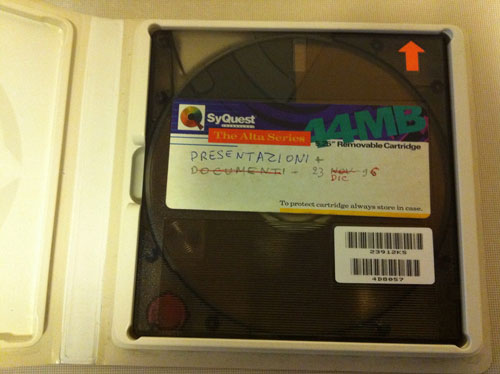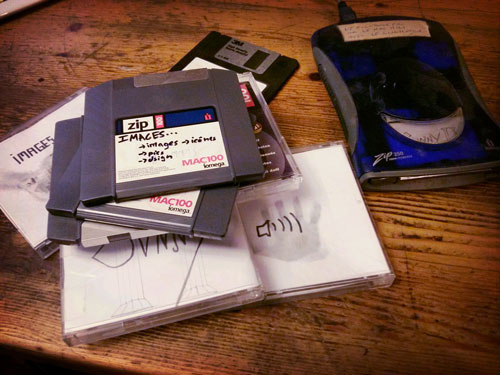An Annoying Clicking Sound
The hardware company Iomega pulled off a neat trick with its Zip disk: It was proprietary, but popular. But it was a bad thing when things started clicking.
Sponsored By … You?
If you find weird or unusual topics like this super-fascinating, the best way to tell us is to give us a nod on Ko-Fi. It helps ensure that we can keep this machine moving, support outside writers, and bring on the tools to support our writing. (Also it’s heartening when someone chips in.)
“There is no philosophy which is not founded upon knowledge of the phenomena, but to get any profit from this knowledge it is absolutely necessary to be a mathematician.”
— Daniel Bernoulli, an 18th-century Swiss mathematician, speaking of the importance of knowing math when monetizing a new technology. Never was this more true than with the Bernoulli Box, Iomega’s first popular product, which came out in the mid-’80s. The disk system, which was named for the way it followed Bernoulli’s Principle, was considered very well-made for its time, but could be quite finicky, and the Box cost thousands of dollars at the time of its release (in part because some models included two disk drives). An Infoworld reviewer, Bernie Zilbergeld, found the product had some issues—largely caused by Iomega itself, which only gave the expensive device a 90-day warranty. “This is an attractive product in many ways and we enjoyed using it, but its high price, short warranty period, lack of self-booting on some machines, and the attention it requires prevent us from giving it a higher rating,” he wrote in 1985. (That said, a 1988 review from the same publication gave an updated version of the system higher marks.)

Five kinds of proprietary PC storage formats used in the ’80s and ’90s
- Magneto-optical disks: First used in Steve Jobs’ NeXT computer, the disks were originally intended to allow users to transfer their entire file systems with them when switching computers. They were too slow for that, alas, but the technology of the format did find a second life in the Sony Minidisc, an obscure format that was Big in Japan, with a modest American cult audience.
- SyQuest drives: Designed to work in a similar way to how NeXT sold its magneto-optical disks, these portable hard disk drives, which literally had disk platters within their cartridge shells, had a cult of popularity comparable to Zip disks—particularly among the desktop publishing crowd, and particularly in the 44-megabyte size. Eventually, though, Iomega outpaced SyQuest, and the firm filed for bankruptcy in 2002, setting the stage for Iomega to take the firm over.
- Compact Floppy Disks: “Over 22 leading American and Japanese makers have agreed on a unified 3” compact floppy disk format for powerful reasons,” a 1983 Hitachi ad argues, citing the disk’s solid build and ability to store as much as a 5 1/4” disk. But the format, which did not have a sliding metal cover, did not have a standards body behind it like the 3 1/2” floppy did, so when Apple went with the slightly larger floppy, the Compact Floppy Disk was relegated to a slow death.
- Floptical drives: These early ’90s devices, which offered 21 megabytes of capacity by adding CD-ROM-style lasers to the format, tried to gain a foothold by offering backwards compatibility with existing 3 1/4” floppies. “These will have a dramatic impact on the tape backup companies,” analyst Gilbert Held told the New York Times at the time. “When you can put 20 megabytes on a single floptical disk, and you have a 60-megabyte or 80-megabyte hard drive, do you really need tape backup?” The answer to that question was yes—tape drives were fairly successful in the ’90s. Floptical, however, wasn’t (likely due to its requirement that users install a controller card), and neither was a spiritual successor, Imation’s SuperDrive.
- SmartMedia cards: Intended to replace floppy disks, these early forms of Flash memory were common in early digital cameras and MP3 players (notably the Diamond Rio), but ultimately failed to win over the initially intended market, in part due to flaws compared to later kinds of Flash memory. One interesting point about these cards: According to PC Magazine, there was at one point an adapter that allowed the flash cards to be read inside of 3.5” floppy drives.
$14.99
The amount that Iomega charged its customers, per phone call, for support regarding their Zip drives, along with Ditto tape-backup devices, starting in 1996. (For the larger-capacity Jaz drives, which were based on a different technology, the cost was $19.99 per call.) This led to a class action lawsuit, the settlement for which failed to blunt the expensive support-call prices—Jaz and Ditto owners got their first phone calls for free, but Zip owners didn’t. It was Iomega’s first brush with controversy, but it was far from its last.

Why Zip disks became so prominent, and why that prominence caused Iomega to belly flop as a company
Do-ba-do. Do-ba-do.
The noise isn’t loud, nor imposing. It’s vaguely rhythmic, even. To most users, it initially sounded like the way that a Zip disk was supposed to work. As it turned out, though, it was an immediate sign that something was terribly wrong with the device.
It was, of course, the big tell that a Zip Drive was a victim of the “click of death,” the infamous design flaw in the proprietary disk drives that sucked the air out of Iomega’s big success story.
And it was one of the better tech success stories of the ’90s: The company, a decade on from its early Bernoulli Box experiment, found major success by selling inexpensive drives that could handle up to 100 megabytes in capacity. At their late-‘90s peak, the drives could be had for $149 for an external model and $99 for an internal one—a sharp decrease in price from the Bernoulli Box.
The idea proved hugely successful, and basically won an audience because the myriad standards bodies had failed to improve the floppy disk in a way that was keeping up with the times. The ability to store files was essential, but few standards of the era were good enough for modern users’ needs. (It didn’t hurt that recordable CD-ROMs weren’t very common yet.)
The success of the Zip Drive was driven by a CEO named Kim B. Edwards, who came from a marketing background at General Electric, rather than from tech. Yes, that’s a trick out of the Apple playbook, and it’s one that proved successful for Iomega, at least at first.
As a 1998 Businessweek article notes, Edwards had the idea of creating a drive that was priced very aggressively, with the goal of taking on the consumer market. He pushed his teams to build such a device in just a year, and when it hit the market, he had the company double down on ads, so as to discourage competition.
Heck, he even convinced major computer manufacturers to make Zip drives a default option on their machines—they were a particularly notable feature on the Power Mac G4, for example, but more importantly for Iomega, Dell also made them standard on their machines as well.
These strategies proved a pretty smart way of getting past Iomega’s traditionally narrow niche of graphic designers and techies. It helped Iomega stand out against all those other proprietary formats out there.
And it helped the company shake off its old image—that of being a company whose products cost hundreds of dollars more than regular consumers were willing to spend.
“It was quickly evident that the company was out of touch with the 50 million or so new computer users,” Edwards told the Times in 1995.
But the rush-rush-rush of the approach eventually caught up with the company, as the “click of death” hinted at some major manufacturing problems.
In early Zip drives, the drive heads would often misalign in everyday use. When you put a disk in one of these broken drives, it had a pesky side effect of misaligning the disks themselves, making them unreadable. And when you put a broken disk inside of a working drive, it was a great way to misalign the drive head of the previously-working drive. It was almost like spreading a disease.
Edwards played the problems off in the press, suggesting that the issues affected less than 1 percent of the drives on the market.
That proved a fatal error—and led to Edwards’ ouster from Iomega in early 1998, amid a period of bad press and quickly declining fortunes.
Iomega built its Zip drive brand on a Gillette model—it sold the drives at low margins and the disks at high margins. But by 1998, the disks weren’t selling, and the company was experiencing big losses. Instead of changing strategy, Edwards doubled down on the aggressive advertising.
“The click of death is the sort of operational snafu—along with other production and service lapses—that led to the kiss of death for Edwards,” Peter Burrows wrote in Businessweek.
The company struggled to right the ship after Edwards’ departure—for one thing, the company’s surging stock cratered after his departure—and the Zip drive failed to gain its mojo back afterwards, even after the company had attempted larger disk sizes.
When you’re in the data-storage business and you can’t ensure the integrity of that data, you might have a problem.
“Last year, the Click of Death was known among a only few people, and many thought it was rumor. Since the introduction of the UICD Home Page at the beginning of 1998, tens of thousands of people from America to Zimbabwe have learned of this very real problem. This site is here to let average consumers make their voice heard.”
— A statement on The Unofficial Iomega Click of Death Home Page, a Geocities website that played an important role in informing the public of the “click of death” problem. The website, which raised concerns about Iomega’s lack of interest in supporting those with damaged devices or lost data, was one of many outlets that played a role in the launch of another class-action lawsuit, against the firm, Rinaldi v. Iomega. That case was settled in 2001, with those affected receiving rebates on other Iomega products.
“Many of those who complain loudest about the company on the Web are particularly bitter about what they consider its longstanding unresponsiveness,” the Times wrote of Iomega in 1998, less than a month before Kim B. Edwards stepped down.
Iomega’s founding predated the Web era, but despite the fact it was clearly focused on building cutting-edge technology aimed at consumers, it failed to understand the importance of the internet as a carrier of bad PR. The rumors of the click of death came at the same time people were making Geocities pages about how awful Internet Explorer is.
Microsoft never let the hate define IE. Iomega, by charging big bucks for something that people expect to get for free, won a battle but conceded the messaging war.
Like many companies of its era, Iomega no longer exists in the form it did during its heyday. It’s been mushed up and merged a couple of times (including, at one point, with SyQuest) and now exists as a subsidiary of Lenovo. Its disks linger on in niche uses, but have been fully supplanted by USB drives, SD cards, and the internet.
For a few years, though, Iomega pulled off an impressive trick: It turned a proprietary platform into a de facto standard.
But it didn’t last. And a big reason for that is how it handled those ominous clicks.
:format(jpeg)/2017/06/tedium120616.gif)
/2017/06/tedium120616.gif)


/uploads/ernie_crop.jpg)